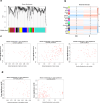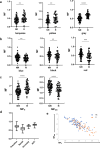Prediction of the risk of transplant rejection based on RNA sequencing data of PBMCs before transplantation
- PMID: 40759993
- PMCID: PMC12322293
- DOI: 10.1038/s41598-025-09780-8
Prediction of the risk of transplant rejection based on RNA sequencing data of PBMCs before transplantation
Abstract
Novel methods for detecting transplant rejection are craved, since conventional methods can detect ongoing rejection that may sometimes have already caused irreversible damage in transplanted organs. Here, we applied a transcriptomics database of recipients' peripheral blood mononuclear cells (PBMCs) before liver or kidney transplantation on the weighted gene co-expression network and machine learning models to evaluate the risk of rejection. Gene clusters positively correlated with rejection were enriched for genes related to antiviral response and regulation/production of interleukin-1(IL-1) in liver transplantation, and genes related to innate immune responses (IL-8 and toll-like receptor signaling pathways) and T cell responses were positively correlated with rejection in kidney transplantation. Our study presents a novel approach for feature engineering based on RNA-seq data of PBMCs collected before transplantation. The features derived from this method demonstrated potential in predicting the risk of rejection and may serve as candidate predictors in future clinically applicable models.
Keywords: Kidney transplantation; Liver transplantation; Peripheral blood mononuclear cells; RNA sequencing; Rejection.
© 2025. The Author(s).
Conflict of interest statement
Declarations. Competing interests: The authors declare no competing interests.
Figures






Similar articles
-
Sex and gender as predictors for allograft and patient-relevant outcomes after kidney transplantation.Cochrane Database Syst Rev. 2024 Dec 19;12(12):CD014966. doi: 10.1002/14651858.CD014966.pub2. Cochrane Database Syst Rev. 2024. PMID: 39698949
-
Discovering molecular signatures in kidney transplant biopsies with borderline changes and isolated V-lesions: single-cell RNA-sequencing analysis of human blood and tissue Spatial transcriptomics.Sci Rep. 2025 Jul 3;15(1):23770. doi: 10.1038/s41598-025-05191-x. Sci Rep. 2025. PMID: 40610502 Free PMC article.
-
Antibody induction versus placebo, no induction, or another type of antibody induction for liver transplant recipients.Cochrane Database Syst Rev. 2014 Jun 5;2014(6):CD010253. doi: 10.1002/14651858.CD010253.pub2. Cochrane Database Syst Rev. 2014. PMID: 24901467 Free PMC article.
-
CCR2 and TLR3: noninvasive macrophage-associated biomarkers of acute renal transplant rejection.Ren Fail. 2025 Dec;47(1):2532856. doi: 10.1080/0886022X.2025.2532856. Epub 2025 Jul 27. Ren Fail. 2025. PMID: 40716784 Free PMC article.
-
Cellular dynamics in pig-to-human kidney xenotransplantation.Med. 2024 Aug 9;5(8):1016-1029.e4. doi: 10.1016/j.medj.2024.05.003. Epub 2024 May 21. Med. 2024. PMID: 38776915 Free PMC article.
References
-
- Beck, J. et al. Donor-derived cell-free DNA is a novel universal biomarker for allograft rejection in solid organ transplantation. Transpl. Proc.47, 2400–2403 (2015). - PubMed
MeSH terms
LinkOut - more resources
Full Text Sources
Medical

